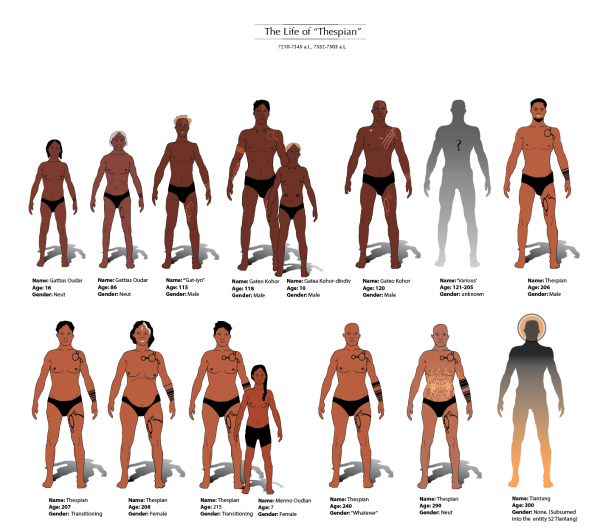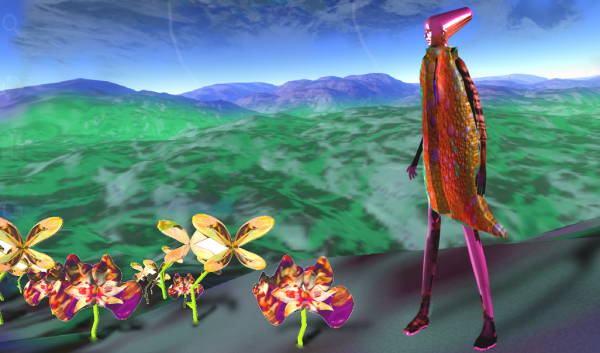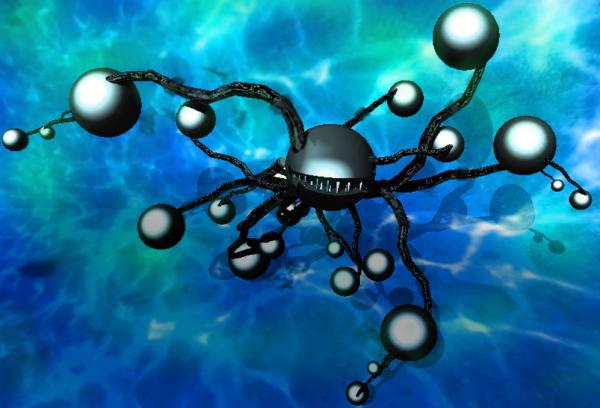BY LETTER
Morphodynamics
Technology > Application > Augmentics
Culture and Society > Cultural Factors
Culture and Society
Technology > Technology Type or Material > Organic/Biotech
Culture and Society > Cultural Factors
Culture and Society
Technology > Technology Type or Material > Organic/Biotech
 Image from Arik | |
| The gradual morphogenesis of Thespian, a largely menomorphic modosophont of the Post-ComEmp era | |
Morphodynamics is the study of how sophonts alter their bodies and minds over time. It encompasses everything from minor alterations to uploading, changing clades, and even breaching toposophic barriers.
The key conceptual tool is the morphological phase space, the multi-billion dimensional space of all possible sophont forms. Each point represents a particular body-state and mind-state. Nearby points are similar states, and distant points are very different. For example, a nearbaseline human is almost next to a pure baseline human in phase space, a provolved primate is slightly further away, and a vec is much further still.
Morphodynamics, then, studies the equations governing how individuals and societies traverse morphological phase space over their lifetimes. In this view, clades are clusters of sophonts in phase space. Individual with unique forms are isolated points.
Scholars identify three types of friction which impede motion through phase space; if this morphodynamic friction is high, then individuals are less likely to alter their physical or mental characteristics.
- Technological friction is almost negligible in the Current Era, but is the primary limited factor in lotech societies.
- Cultural friction is much more variable; among the Sephirotics, the TRHN and Keter have the lowest cultural friction, while the Utopia Sphere and the Terragen Federation have the highest.
- Finally, toposophic friction is a measure of resistance against movement between toposophic levels, but appears to be moderately high in most modosophont cultures, mostly because of the risks involved.
 Image from Steve Bowers | |
| Ladian NcDance in an (approximately) humanoid form | |
Menomorphs and Rheomorphs
Individual sophonts are categorised according to whether they change form readily or otherwise. Menomorphs tend to remain in the clade they were created in. Rheomorphs change often, either switching between clades or pursuing their own, unique paths. (Ladian NcDance is an archetypal rheomorph). Of course, these categories are not absolute, and their usage in the literature is not always consistent.Cyclic menomorphs, for instance, may regularly experiment with different forms. However, they always have a home clade to which they remain faithful.
Evaporative menomorphism is a common phenomenon. Take a new clade with members who have varying attitudes to self-modification. Over time, some will become rheomorphs, thereby leaving the clade. This leaves behind menomorphs, who are less inclined to modify themselves. Because rheomorphs are split between those who adopt another clade and those who explore morphological phase space independently, on average more rheomorphs leave a given clade than join it. Consequently, there are usually more sophonts who were created in a clade than who joined it later, although this does not apply to certain popular morphological types.
 Image from Steve Bowers | |
| Ladian NcDance in eir Seaweed form | |
Contact with new alien life forms often causes rapid shifts in phase space across the Terragen Sphere. Newly encountered non-sophont alien life forms might be provolved into sophonce, the new xenosophonts and xenoprovolves experiment with changing clades (often becoming humanoid in appearance, in order to blend in more easily), and Terragen clades experiment with the new forms available to them. These shifts are often labelled contact shocks.
Related Articles
- Body Transformation Protocols
- Heteromorphs
- Historico-Sociomorphotypal Criticism - Text by M. Alan Kazlev
Social Science that deals with the understanding and analysis of the morphotypic, social, and cultural characteristics and evolution of a clade, culture, memeplex, or polity; used to distinguish the real meaning from the apparent and usually popular literal or superficial interpretation. An important element in historical and cliological reconstructions. - Ladian NcDance
- Moodomorphic
- Morphological Freedom
- Morphology - Text by M. Alan Kazlev
The shape of something, especially the organic form of a living being. Also, the study of how morphology is regulated in complex systems such as developing tissues or nanosystems. - Morphotype
- Transbiomorphosis - Text by Adaptecd from Max More, in Anders Sandberg's Transhuman Terminology
[1] (Interplanetary Age, First Federation, Terragen Federation): The transformation of the human body from a natural, biological organism into a superior, consciously designed vehicle of personality.
[2] Genetekkers, Genen, Zoeific Biopolity, TRHN - dramatic modification of one's biological form, not necessarily into a superior (although sometimes that) but just a different form, as a lifestyle choice or artistic expression. - Translation Metamorphosis
Appears in Topics
Development Notes
Text by Liam Jones
Initially published on 27 June 2018.
Initially published on 27 June 2018.






